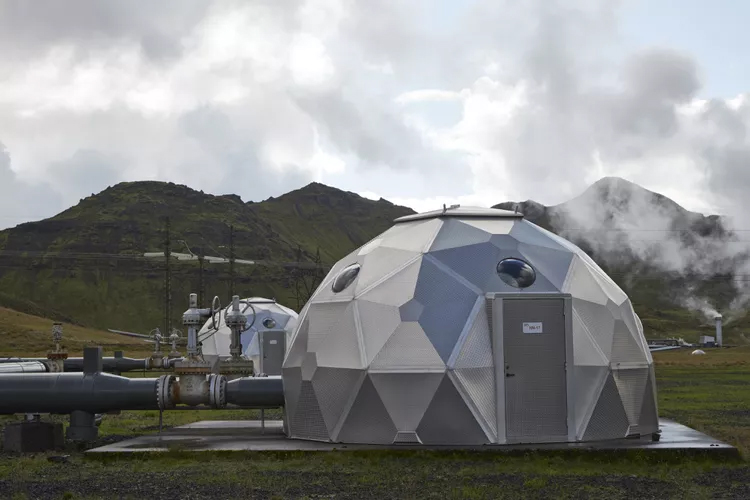|

September 10, 2023
By
Mike Wilowski
Why Companies From Microsoft to Shopify
Are Investing Millions in Carbon Removal
They're partnering with startups
like Heirloom that develop carbon capture technologies

Bloomberg / Contributor / Getty Images
Companies
such as Microsoft, Shopify, H&M, and payments company Stripe are
investing millions in carbon removal, the process of extracting carbon
dioxide from the atmosphere to limit the impact of climate change.
It's an effort that continues to attract investment from companies
eager to show they are addressing climate issues while simultaneously
lowering the cost of such efforts through rapidly evolving
technologies.
KEY TAKEAWAYS
Companies including Microsoft, H&M, Shopify, and Stripe have spent
millions on carbon capture technologies and partnered with
sustainability-focused startups.
Carbon capture, or carbon removal, is the process of removing carbon
dioxide from the atmosphere and trapping it in some form.
It can be achieved through natural means, such as reforestation and
soil management, or through man-made techniques like carbon air
capture.
Carbon capture is among many strategies that could reduce the impact
of climate change, and keep temperature rise limited to 1.5 degrees
Celsius as outlined in the Paris Climate Agreement.
Carbon capture is among many
strategies that could reduce the impact of climate change, and keep
temperate rise limited to 1.5 degrees Celsius, as outlined in the 2015 Paris
Climate Accord.1
Corporate support for carbon capture technologies has
been growing. Frontier, a nine-year carbon capture initiative founded
in 2021 by Alphabet (GOOGL),
Meta (META),
McKinsey, Shopify (SHOP)
and Stripe,2 has
raised more than $1 billion in funding to help lower the cost
per-metric-ton of carbon capture.3
"With Frontier, we want to send a loud demand signal to
entrepreneurs, researchers, and investors that there is a market for
permanent carbon removal: build and we will buy," said Nan Ransohoff,
head of climate at Stripe.4
Members Stripe, Shopify, and H&M on Thursday committed
to another $7 million in carbon removal technologies from 12
sustainability-focused startups: Airhive, Alkali Earth, Banyu Carbon,
Carbon Atlantis, CarbonBlue, CarbonRun, EDAC Labs, Holocene, Mati,
Planetary Technologies, Spiritus Technologies, and Vaulted Deep. Based
on their own estimates, these companies could collectively remove up
to half a million tons of carbon dioxide annually by 2026.5
Microsoft and Heirloom
Those aren't the only companies
investing heavily in carbon capture. Microsoft (MSFT)
has partnered with Heirloom, an industrial design startup, purchasing
up to 315,000 metric tons of the former's direct air capture
technology—a carbon removal process that extracts carbon
dioxide directly from the atmosphere.67
The decision comes a month after Heirloom was chosen as
one of two firms awarded by the Energy Department for $1.2 billion in
funding for the construction of air capture facilities. Heirloom is
slated to receive half this amount for a direct air capture hub in
Louisiana.89
How It Works
Carbon capture, or carbon removal, is the process of
removing carbon dioxide from the atmosphere and trapping it in some
form, whether in trees, rocks, soil, water, or man-made structures
such as buildings and concrete. Once entrapped, carbon dioxide can be
locked away for centuries if not millennia. Strategies for
implementing carbon removal are often called negative emissions
technologies (NETs).10
The direct air capture costs are more than 50 times the
cost per metric ton of most natural climate solutions, according to
Microsoft.11 To
cover costs, direct
air capture companies sell the byproduct, CO2, to other companies,
such as oil companies that put that byproduct to use pumping more oil
out of older wells.
Carbon capture can occur through natural means, such as
reforestation and agricultural soil management, or via man-made
techniques like carbon air capture, which directly extracts carbon
dioxide from the atmosphere. Hybrid strategies also exist, including
using bioenergy with carbon capture and storage, and ocean-based
carbon removal.1
Government Support
Government involvement will
be necessary to achieve the goals outlined in the Paris Climate
Accord. Some 40 countries have carbon pricing mechanisms, with more
planning to implement them in the future.12
In 2021, the White House pledged up to $11 billion a
year dedicated to climate support for developing nations. And in
April, President Biden announced the U.S. is providing an additional
$1 billion to the U.N.-backed Green Climate Fund (GCF), bringing the
U.S. commitment to $2 billion.13 The
GCF funds projects to accelerate clean energy transitions and
encourage private investment.
Green Play Ammonia™, Yielder® NFuel Energy.
Spokane, Washington. 99212
509 995 1879
Cell, Pacific Time Zone.
General office:
509-254
6854
4501 East Trent
Ave.
Spokane, WA 99212
|